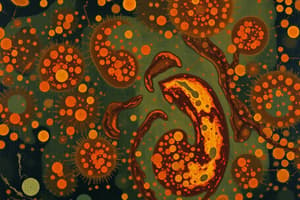Podcast
Questions and Answers
Which of the following is an example of microbial antagonism?
Which of the following is an example of microbial antagonism?
- Transient microbiota causing a temporary infection.
- Resident microbiota preventing pathogens from causing an infection. (correct)
- The body's surfaces being routinely free of microorganisms.
- Changes in normal microbiota due to genetics, of the host.
How does the dynamic composition of normal microbiota respond to physiological variations in the host?
How does the dynamic composition of normal microbiota respond to physiological variations in the host?
- By changing to the physiological variations, genetics, and activities of the host. (correct)
- By causing disease when the host's defenses are strong.
- By remaining constant regardless of any changes in the host.
- By changing in response to the host's genetics.
A patient is taking antibiotics, leading to a decrease in their intestinal microbiota. What is a potential consequence of this?
A patient is taking antibiotics, leading to a decrease in their intestinal microbiota. What is a potential consequence of this?
- Overgrowth of antibiotic-resistant organisms like _C. difficile_. (correct)
- Increased production of essential vitamins.
- Enhanced immune response within the intestine.
- Decreased susceptibility to opportunistic pathogens.
Which of the following conditions is most likely to result from the administration of antibiotics that suppress Lactobacillus in the female reproductive tract?
Which of the following conditions is most likely to result from the administration of antibiotics that suppress Lactobacillus in the female reproductive tract?
What must a pathogen do to cause disease in a host?
What must a pathogen do to cause disease in a host?
What is the best definition of virulence?
What is the best definition of virulence?
Which portal of entry is the easiest and most frequently traveled?
Which portal of entry is the easiest and most frequently traveled?
How does adherence contribute to a microbe's pathogenicity?
How does adherence contribute to a microbe's pathogenicity?
What is the role of coagulase in bacterial pathogenicity?
What is the role of coagulase in bacterial pathogenicity?
How do kinases such as streptokinase contribute to a pathogen's ability to cause infection?
How do kinases such as streptokinase contribute to a pathogen's ability to cause infection?
How does hyaluronidase enhance the virulence of certain bacteria?
How does hyaluronidase enhance the virulence of certain bacteria?
Clostridium botulinum produces a neurotoxin that causes paralysis by preventing nerve-muscle stimuli. Which of the following describes this mechanism of action?
Clostridium botulinum produces a neurotoxin that causes paralysis by preventing nerve-muscle stimuli. Which of the following describes this mechanism of action?
Which of the following characteristics distinguishes endotoxins from exotoxins?
Which of the following characteristics distinguishes endotoxins from exotoxins?
Which of the following is a portal of exit?
Which of the following is a portal of exit?
Which of the following is an example of pathogen adherence?
Which of the following is an example of pathogen adherence?
Which of the following is an example of a virulence factor of the pathogen used to avoid phagocytes?
Which of the following is an example of a virulence factor of the pathogen used to avoid phagocytes?
Which of the following is an example of an exoenzyme?
Which of the following is an example of an exoenzyme?
How do some bacteria avoid host defenses?
How do some bacteria avoid host defenses?
How does the ID50 of a pathogen impact the likelihood of infection?
How does the ID50 of a pathogen impact the likelihood of infection?
If Salmonella typhi enters through the skin, will typhoid fever occur?
If Salmonella typhi enters through the skin, will typhoid fever occur?
Flashcards
Normal Microbiota (Flora)
Normal Microbiota (Flora)
Organisms that routinely reside on the body's surfaces.
Resident Microbiota
Resident Microbiota
Permanent colonies that don't cause disease.
Transient Microbiota
Transient Microbiota
Microbes that inhabit temporarily.
Microbial Antagonism
Microbial Antagonism
Signup and view all the flashcards
How Pathogens Cause Disease
How Pathogens Cause Disease
Signup and view all the flashcards
Virulence
Virulence
Signup and view all the flashcards
Virulence Factors
Virulence Factors
Signup and view all the flashcards
Portal of Entry
Portal of Entry
Signup and view all the flashcards
respiratory tract
respiratory tract
Signup and view all the flashcards
Unbroken Skin
Unbroken Skin
Signup and view all the flashcards
The Parenteral Route
The Parenteral Route
Signup and view all the flashcards
ID50 (Infectious Dose)
ID50 (Infectious Dose)
Signup and view all the flashcards
Adherence
Adherence
Signup and view all the flashcards
Virulence of a microbe
Virulence of a microbe
Signup and view all the flashcards
Antiphagocytic factors
Antiphagocytic factors
Signup and view all the flashcards
Leukocidins
Leukocidins
Signup and view all the flashcards
Coagulase
Coagulase
Signup and view all the flashcards
Kinases
Kinases
Signup and view all the flashcards
Hyaluronidase
Hyaluronidase
Signup and view all the flashcards
Toxins
Toxins
Signup and view all the flashcards
Study Notes
Host-Microbe Interaction
- Humans are colonized by microbes at birth and continuously throughout their lifetime.
- A fetus is sterile until birth, with the first exposure to microbes occurring during passage through the birth canal.
- The human body constantly comes into contact with many microorganisms daily by breathing, ingesting food/drink, and skin contact.
- Relatively few microbes encountered are pathogenic.
- Normal microbiota (flora) routinely reside on the body's surfaces.
- Resident microbiota are permanent colonies that do not cause disease.
- Transient microbiota inhabit the body temporarily.
- Normal microbiota prevents pathogens from causing infection through microbial antagonism.
- The composition of normal microbiota is dynamic and changes due to physiological variations, genetics, and host activities.
- Intestinal microbes of obese and lean individuals differ.
- The Human Microbiota Project aims to better understand the effects of microbiota.
- Host/Microbe relationship is a delicate balance.
- Infection or disease occurs when the balance favors the microbe.
- Microbial pathogenicity mechanisms are key to understanding how pathogens overcome host defenses.
- Some microbes only cause disease when there is an opportunity
- This may due to weakened defenses (immunocompromised).
- It may also due to antibiotic treatment suppressing or killing other microorganisms, enabling over-colonization.
- Some antibiotics inhibit Lactobacillus in the vagina, which normally suppresses Candida albicans, leading to yeast infections.
- Oral antibiotics can inhibit intestinal microbiota, causing an overgrowth of C. diff.
- Disease can result from organisms in unusual locations. Growing organisms in a relatively germ-free environment can also have negative effects.
Pathogenicity Overview
-
For a pathogen to cause disease, it must:
-
Gain access to the host
-
Adhere to host tissues
-
Penetrate or evade host defenses
-
Damage the host directly or through waste accumulation
-
Infectious diseases yield objective signs and subjective symptoms from the damage
-
Virulence is the degree of pathogenicity.
-
Virulence factors are traits that enable a pathogen to cause disease.
-
The course of infectious diseases includes the incubation period, illness, and convalescence (recovery).
Mechanisms of Pathogenicity
- When the host-microbe balance favors the microbe, infection or disease can occur.
- The cycle includes: portal of entry -> number of invading microbes + adherence -> penetration or evasion of host defenses -> damage to host cells -> portal of exit
Portals of Entry
- Microbes enter through portals of entry, and exit through portals of exit.
- Common portals of entry include:
- Mucous membranes (respiratory, gastrointestinal, genitourinary tracts, conjunctiva)
- Skin
- Parenteral route
- Respiratory Tract: Microbes are inhaled into the mouth or nose via moisture droplets or dust particles. This is considered the easiest and most common route of entry.
- GI Tract: Microbes enter through contaminated food, water, fingers, and hands; most are destroyed by enzymes or bile.
- Genitourinary System: STDs fall into this category
- Conjunctiva: Microbes gain entrance in the mucus membranes covering the eyeball and lining the eye.
- Skin: An effective barrier when unbroken, some microbes enter through openings such as hair follicles and sweat glands.
- Parenteral Route: Microbes are deposited below the skin or mucous membranes via punctures, injections, bites, scratches, surgery, or skin splitting due to swelling or dryness.
- Pathogens must enter the body through a portal that allows them to cause disease.
Preferred Portal of Entry
- Salmonella typhi causes typhoid fever only when it enters the GI tract but not when on the skin.
- Some can cause disease from multiple portals eg. Bacillus anthracis.
Number of Invading Microbes
- The likelihood of disease increases with more invading pathogens.
- ID50 (Infectious Dose) is the number of microbes needed to infect 50% of a population.
- ID50 varies for different pathogens and portals of entry for the same pathogen.
- Skin: 10-50 endospores
- Inhalation: 10,000-20,000 endospores
- Ingestion: 250,000-1,000,000 endospores
- LD50 (Lethal Dose) is the amount of toxin needed to kill 50% of a population within a specific time frame.
- Adherence is microbe attachment to a host at the portal of entry, is needed for virulence, and can be prevented by blocking adhesion.
- Adherence involves specific molecule binding between host and pathogen.
Virulence and Host Defenses
- Virulence is indicated by a microbe's ability to establish itself in the host and cause damage.
- Pathogens encounter resistance from host defenses (e.g., phagocytes).
- Antiphagocytic factors are virulence factors that help pathogens avoid phagocytes.
- Some microbes outright kill phagocytes by producing leukocidins toxic to WBCs (e.g., Streptococcus and Staphylococcus)
- Capsules can prevent phagocytosis (e.g., Streptococcus pneumoniae)
- Slime layers make it difficult for phagocytes to engulf microbes.
- Some survive inside phagocytes due to their cell wall composition (e.g., Mycobacterium)
Damage to Host Cells
- Pathogens that survive host defenses can damage host cells. Damage can be done by:
- Secreting proteins (enzymes/toxins) directly.
- Exoenzymes:
- Coagulase: clots fibrin in blood, creating a protective barrier against host defenses and preventing phagocytosis by WBCs (e.g., Staphylococcus)
- Kinases: dissolve clots to allow escape from isolated wounds (e.g., Streptokinase (S. pyogenes) and Staphylokinase (S. aureus))
- Hyaluronidase: breaks down hyaluronic acid ("glue" in connective tissue), allowing deeper invasion (e.g., Staphylococcus, Streptococcus, Clostridium)
- Toxins: are poisonous chemicals:
- Toxemias: toxins spread by blood from the site of infection (e.g., tetanus)
- Intoxications: result from the ingestion of toxins (e.g., botulism)
- Toxins are named based on their specific target:
- Neurotoxins: target the nervous system. (Clostridium toxins interrupt key cell pathways and prevent nerve-muscle stimuli transmission)
- Enterotoxins: target the intestines
- Hemotoxins: target RBCs (hemolysins are discussed as Streptococcus pyogenes and Staphylococcus aureus)
- Nephrotoxins: target the kidneys
- **Exotoxins are secreted by living bacteria into the infected tissue.
- Endotoxin is shed from the outer membrane of gram-negative bacteria, and causes a systemic response with fever, inflammation etc eg. Neisseria, E. coli, Shigella.
Exotoxins vs. Endotoxins
- Exotoxins:
- Source: Gram-positive and gram-negative bacteria
- Relation to microbe: By-products of growing cell
- Chemistry: Protein
- Fever: No
- LD50: Small
- Endotoxins:
- Source: Gram-negative bacteria
- Relation to microbe: Outer membrane
- Chemistry: Lipid A
- Fever: Yes
- LD50: Relatively large
- Additional Pathogenic Effects
- Causing an overreaction of the body's defenses that results in damage
- Host excessive or inappropriate response to a microorganism.
- Pathogenicity is not just influenced by the characteristics of the microorganisms.
- Alteration of the host cell genome or transcription processes.
- Microbes shut down or activate DNA regions via epigenetic processes.
- Changes the way host cells function and may persist, causing continuing symptoms.
Portals of Exit
- Means of exit by pathogens, often released during secretion, excretion, or discharge.
- High pathogen numbers increase the likelihood of reaching a new host.
- V. cholerae induces watery diarrhea (up to 20L a day).
Studying That Suits You
Use AI to generate personalized quizzes and flashcards to suit your learning preferences.



